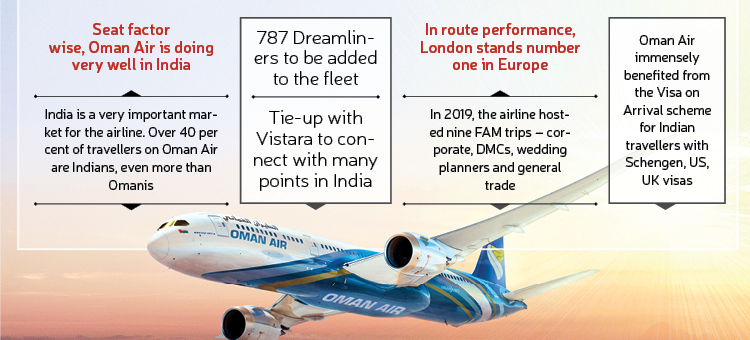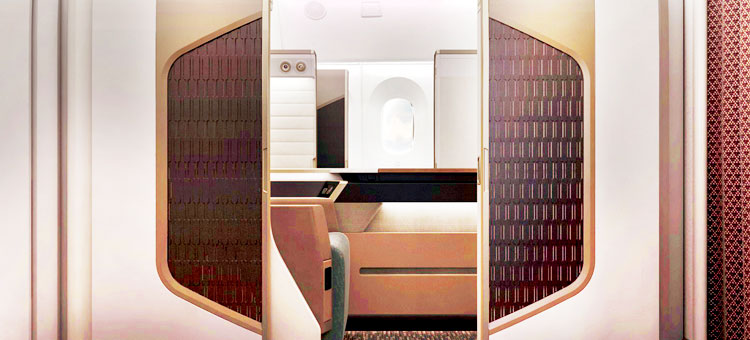Mumbai: With 11 stations and 161 flights a week – Delhi (three flights daily); Lucknow (two flights daily), Jaipur (one flight daily), Goa (one flight daily), Mumbai (double daily), Hyderabad (three flights daily), Bengaluru (two flights daily), Chennai (two flights daily), Kochi (two flights daily), Kozhikode (three flights daily) and Thiruvananthapuram (one flight daily) – Oman Air is one of the largest foreign carriers operating in India. The last point Goa was announced in 2015 exhausting their bilateral quota. The opening of the new Muscat International Airport in March 2018 was a watershed moment for the tourism and airline sectors of the Gulf nation. Over 40 per cent of travellers on Oman Air are Indians. India is a very important market for the airline.
Oman Air veteran Sunil V A, Regional Vice President, ISC spoke to Destination Reporter recently on his plans and priorities.
What are your priorities in 2020?
In 2020 we will focus on stabilizing our existing routes. As you may be aware, we are short of fleet due to the grounding of the Boeing 737 MAX aircraft. Our MAX order stays and hope the issue with this aircraft is sorted out at the earliest. We have 787 Dreamliners also coming in and have upgraded a few routes including Mumbai and Delhi to wide-bodied aircraft and few more will follow.
A lot of cooperation is being planned with our codeshare and interline partners. This will ensure growth in 2020. We have agreements with leading airlines in the Americas, Europe, Middle East, GCC, South Asia and the Far East to enhance our reach across the globe. Our partnership with Lufthansa can connect guests from Munich and Frankfurt, two points in Germany we fly to.
We have signed an SPA (Special Prorate Agreement) with Vistara to connect with many points in India. Earlier, we used to have a similar agreement with Jet Airways.
What has been the impact of the grounding of Boeing 737 MAX?
We had five Boeing 737 MAX aircraft delivered to us and we operated it for almost a year. We started flying them in April 2018 and in March 2019 when the incident got reported, we grounded all five. As per the original plan, we were supposed to have 11 of them. We fly these birds a minimum of 13-14 hours every day. So you can imagine the impact! Our shortage of aircraft hopefully should get addressed soon.
Our India routes are not impacted by the MAX issue and all flights operate as normal. We have upgraded the BOM and DEL flights to wide-body and both the routes are doing exceptionally well with state-of-the-art wide-body product.
Can you share some of the key performance metrics? Is there room for growth?
In India we do not want to reduce frequency as all routes are doing very well.
Our seat factor is 82-83 per cent currently with limited room to grow. One cannot imagine a seat factor of 90 per cent and above anyways. So our growth has to come from alliances and partners. We can increase seat factor by 5-6 per cent but it is also about maximizing value and revenue from that growth. We have been slowing down many businesses which we were doing traditionally, in order to enhance value.
I am happy to report that in 2019, Oman Air had an average price growth of 12 per cent in the India market which is great. It means that our strategy of choosing higher value travellers is working. Our load factor has remained the same but we have realised a better price. We chose our traffic. We sold more long haul than short-haul. We will continue to do the same this year as well because our capacity is not increasing.
In route performance, London stands number one in Europe. Our traffic to London has been predominantly leisure and corporate. We have ethnic traffic to Paris from Pondicherry. We do well in Zurich, Munich and Milan too. Many fixed departures happen to these cities from India. Last year saw success in Manchester due to the ICC CWC. At the recent VisitBritain roadshow, more than half of the delegates were from the North of England.
What has been the impact of coronavirus?
For the summer in Europe, over 30,000 passengers have been booked with us. Actually, we should be celebrating. But the joy of pre-selling has gone out of the window, thanks to how global developments can impact travel. Sales teams are scared now when booking pipeline looks good. What if cancellations happen say two months from flying date, what do you do? We sold them six months ago and were hoping pre-sold will hold good! Every year, we now have such developments that impact our business adversely – last year it was Sri Lanka where our station was doing very well when the Easter Sunday attacks took place. This year it has been the coronavirus.
Aircraft and airports are vulnerable to spreading any epidemic. All discretionary travel will get postponed as guests do not want to take any chances. Usually, such incidents result in a cycle of cancellations due to word of mouth. We really hope the situation gets contained soon. Luckily, it is not high season for us. We used to fly to Guangzhou. We suspended our flights on January 31 as the news broke.
Of late Oman has become a sought after MICE and Wedding destination. How do you see this transformation?
We have always been talking about Oman and not Oman Air, the focus is more intense now. We are the proud national carrier and our intent is to promote the destination and not just the airline. We have seen great success with our leisure and MICE campaigns. We saw good MICE movements in 2019. The wedding segment is catching up well as hotels and resorts in Oman provide the luxurious setting and absolute privacy for Indian weddings. They are usually buyouts with 200-500 people attending. In many other destinations since hotel inventories are large, the wedding party is still one of the many groups and there will not be any exclusivity. Not just Indian weddings but even birthdays, anniversaries and engagements are now being held in Oman.
The Visa on Arrival scheme announced last year for Indian travellers with any of the big visas – Schengen, US, UK – has helped a lot. It is just OMR 5 or Rs. 800. This has encouraged weekend holidays to Oman. Many FITs are travelling to Oman especially during the October to March season as Oman is an outdoor destination and the weather is amazing during this time. The 10-day tourist visa is only OMR 10.
How is the First Class Suite performing as a product?
We sell this product only on the London route. Mumbai, Delhi, Bengaluru and Chennai stations have been doing well on this front. Recently, we have seen success in Hyderabad market as well. Last year from October, we have seen premium traffic increase from Hyderabad. We had interacted with the CEO community there and once they learned about the product and tried it, they have become repeat customers. First Class as a category has a lot of potential. We have this only from Oman to the UK. Many carriers have First Class seats from India as well and they are doing very well too. London is an established route. If you have a good product at a good price, it will sell on the London route.
Can you share details of how you are engaging with the trade?
Last year we did GPS EDWIN to Manchester as their airline partner. This year we are planning to do GPS EDWIN to Oman. In 2019, we hosted nine FAM trips – corporate, DMCs, wedding planners and general trade. This year the focus is to take couples in business. We don’t want to do this in groups to ensure we can have focused discussions and follow ups.
There is a lot of interest among DMCs in Oman as well to come to India as they see many Indians travelling to Oman. Khimji Travels has appointed a new representative in India; Tour Oman was at the OTM. Zahara Tours was at many other events. Bahwan Travels has been active in the MICE segment, Arabica team has been making frequent sales visits to different markets, and we have many new DMCs which plan to visit India in 2020 to tap this market.
What are you doing to enhance the flying experience?
Most of the points in India are just 2.5 hours from Muscat. So it’s a very short journey. We are focusing on creating better cabins and ensuring local language speaking staff. Our in-flight menu is updated every three months and uplifted locally so that customers can enjoy the food they like.
With the opening of the new Muscat International Airport, comfort in transit is now guaranteed. We have reduced transit timing and connect to most points in 2-2.5 hours. This has ensured many more people are now travelling with us. We are the best compared to other one-stop airlines flying from India to any of our points in Europe via GCC. We reach in 13-14 hours.








